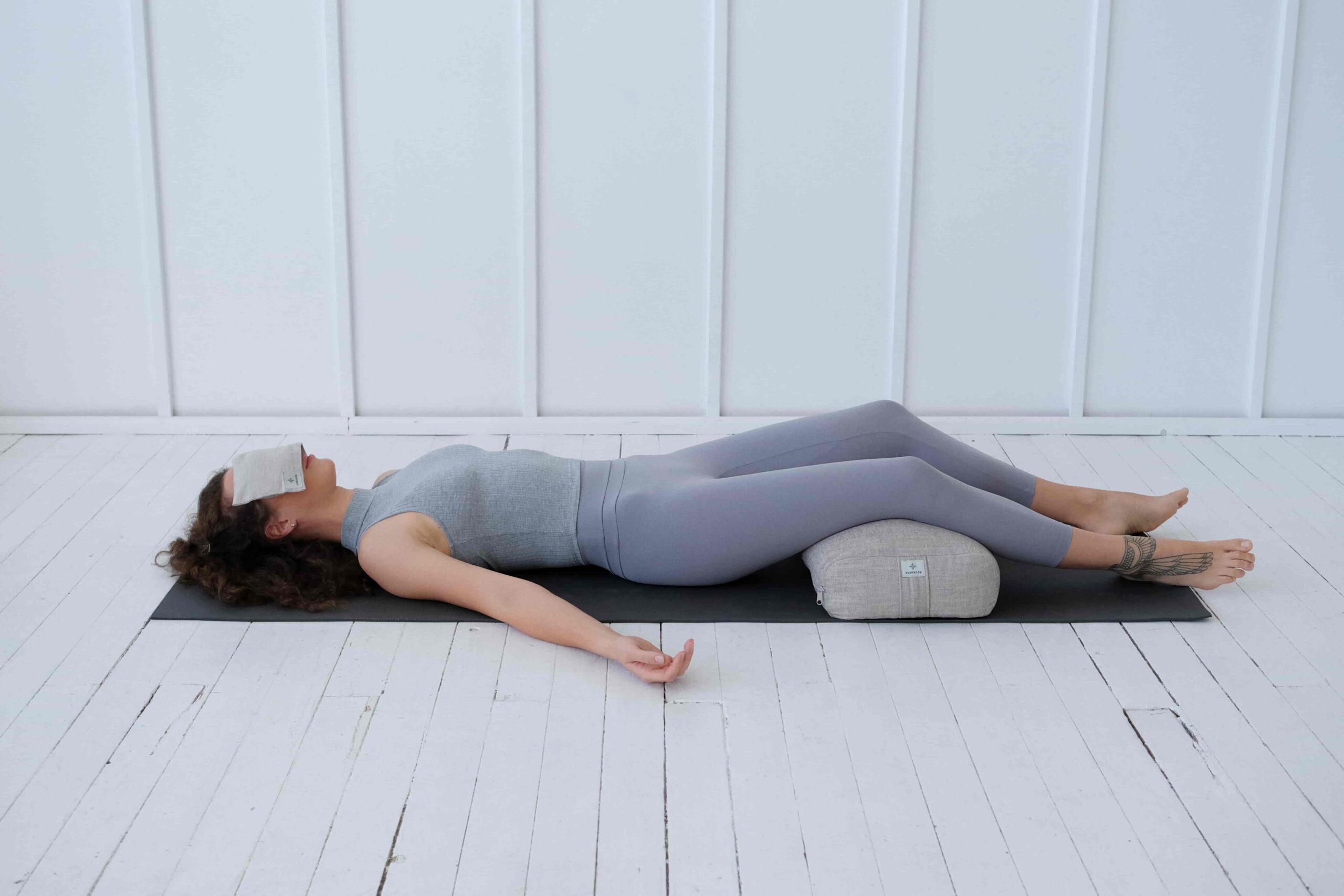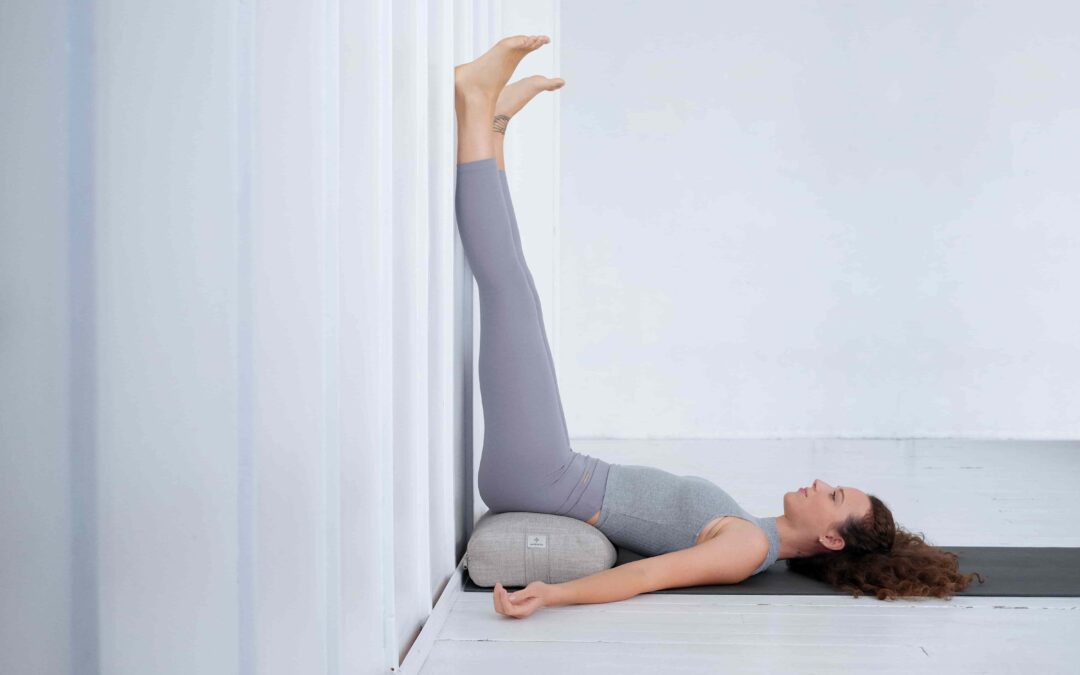Yoga bolster: restorative yoga is a gentle practice that focuses on relaxation and stress relief through supported poses. When combined with a yoga bolster, a firm cushion used for support, it enhances the restorative experience by allowing the body to fully relax into each posture. Here are 7 restorative yoga poses with a bolster that can help you unwind and release tension. Just 20 minutes practice in the evening can promote deep relaxation and significantly improve your sleep.
1. Supported Child’s Pose

Child’s Pose with a bolster is a common and soothing yoga pose often found in restorative or yin yoga classes. This gentle stretch helps to ease tension in your back and hips, making it perfect for relaxing before bedtime or unwinding after a stressful day.
- Begin by placing the bolster lengthwise on your mat.
- Sit on your heels and place the bolster between your thighs.
- With knees wide apart, fold forward, allowing your torso to rest on the bolster.
- Extend your arms forward or place them by your sides for added support.
- Relax your forehead on the bolster and breathe deeply, feeling a gentle stretch in your hips and spine.
- Hold for 3-5 minutes, focusing on slow, rhythmic breathing.
2. Supported Child’s Pose left and right side variations

Supported Child’s Pose left and right side variations are very helpful for stretching left and right side of you torso and spine.
- Begin by placing the bolster lengthwise on left side of your mat.
- Sit on your heels and place the bolster on left between your thighs.
- With knees wide apart, fold forward to the left, allowing your torso to rest on the bolster.
- Extend your arms forward or place them by your sides for added support.
- Relax your forehead on the bolster and breathe deeply, feeling a gentle stretch in your right side of your chest
- Hold for 3-5 minutes, focusing on slow, rhythmic breathing.
- Repeat with the right side stretch.
3. Reclining Butterfly Pose

The Reclining Butterfly pose is a lovely way to open up your hips while also stretching your lower back, chest, and inner thighs. To make this pose even more restorative, add a bolster for extra support. Here’s how to do it:
- Lie down on your back and place the bolster under your spine for support.
- Bend your knees and let them fall open, similar to the Butterfly Pose.
- Keep your arms relaxed by your sides.
- Allow your hips to relax into the support of the bolster. If you feel any discomfort in your hips, you can place cushions under your knees for added support.
- Hold this restorative pose for 3 to 5 minutes, focusing on deep breaths and releasing tension.
With the bolster providing support, you can fully surrender into the pose and experience deep relaxation in your body.
4. Bridge Pose

Bridge Pose is a great way to open up your chest and release tension from your shoulders using a yoga bolster. It provides a gentle approach to strengthening your back and elongating your spine.
While there are various versions of this pose, incorporating a bolster offers a more passive variation that emphasizes chest opening and spinal stretching. Here’s how to practice Bridge Pose with a bolster:
- Begin by lying on your back with your knees bent and feet hip-width apart.
- Place the bolster underneath your hips, aligning it parallel to the shorter side of your mat.
- Walk your feet in towards your body, allowing the bolster to support your hips and elevate them off the ground.
- Relax your arms by your sides or extend them overhead, whichever feels more comfortable.
- Focus on releasing tension from your shoulders and opening the front side of your upper body.
- Alternatively, you can choose to extend your legs and relax your feet, depending on your preference and comfort level.
Hold this pose for several breaths, allowing your chest to expand and your spine to lengthen. Enjoy the passive stretch and the sense of openness it brings to your chest and shoulders.
5. Wide-Legged Forward Bend Pose

Wide-Legged Forward Bend is a highly effective pose for releasing tension in the back, hamstrings, and hips. When practiced with a bolster, it becomes an even more powerful stretch, allowing for a deeper release in the body.
- Turn to face the long side of your mat and place your bolster in front of you.
- Place your feet wider than hip-width apart.
- Stand the bolster up between your feet so that it leans toward you.
- Fold forward, anteriorly tilting your pelvis and keeping length in your lower back.
- Rest your forehead on the top of the bolster and let your thoracic spine round.
To come out, slowly reach up through the crown of your head to lift away from the bolster, gently unfurling your spine. Straighten your legs, pointing and flexing your feet and toes as a brief counterpose.
6. Supported Legs-Up-the-Wall Pose

Supported Legs-Up-the-Wall Pose is a gentle inversion that offers numerous benefits such as relieving lower back tension and improving blood circulation throughout the body.
While traditionally practiced with the legs resting against a wall, it can sometimes be challenging to fully relax in this pose, particularly when practicing without a wall for support. Here’s how to use a yoga bolster to enhance your experience:
- Sit sideways next to a wall with your bolster behind you.
- Lie on your back and swing your legs up the wall, placing the bolster under your hips for support.
- Adjust the distance of the bolster to find a comfortable stretch in your hamstrings and lower back.
- Rest your arms by your sides with palms facing up.
- Close your eyes, relax your breath, and surrender to the gentle inversion.
- Hold for 5-10 minutes, allowing gravity to release tension and promote relaxation.
7. Savasana (Corpse Pose)

After completing a sequence of yoga poses with a bolster, it’s beneficial to conclude the session with Corpse Pose, also known as Savasana. This final relaxation posture helps to soothe the entire body, making it an ideal way to end any yoga practice, particularly after an intense session. It is very relaxing to use Eye pillow with linseed.
If you find it challenging to fully relax or experience discomfort in your lower back or legs during Savasana, using a bolster can provide added support and comfort. Here’s how to incorporate a bolster into your Savasana practice:
- Lie on your back with your legs extended and arms by your sides, palms facing up.
- Place the bolster under your knees to support your lower back.
- Close your eyes and allow your entire body to relax into the mat.
- Scan your body for any remaining tension and consciously release it with each exhale.
- Let go of any thoughts or distractions, and simply be present in stillness.
- Remain in Savasana for 5-10 minutes, soaking in the benefits of deep relaxation.
Incorporating a bolster into your restorative yoga practice can deepen your relaxation experience and promote overall well-being. These seven poses offer a combination of gentle stretches, supported inversions, and deep relaxation techniques to help you unwind, release tension, and restore balance to body and mind. Whether practiced individually or as part of a sequence, these restorative yoga poses with a bolster can be a powerful tool for cultivating a sense of calm and rejuvenation in your daily life.

